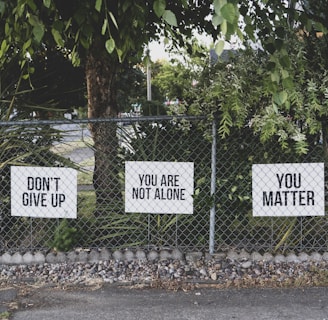Finding Hope in the 12-Step Rooms
Addiction is a powerful force that can consume lives, wreak havoc on relationships, and leave individuals feeling isolated and hopeless. But in the midst of this darkness, many people have found a beacon of hope in the 12-step recovery rooms. These programs, built around the guiding principles of mutual support and spiritual growth, offer a lifeline for those struggling with addiction.
5/8/20244 min read


The Birth of the 12 Steps
The 12-step model was created in 1935 by Bill Wilson and Dr. Bob Smith, the founders of Alcoholics Anonymous (AA). Originally designed to help people struggling with alcohol addiction, it has since been adapted to address a wide range of addictions, including narcotics, food, gambling, and more.
At its core, the 12-step program is based on the idea that people need a framework for living that not only helps them stop using substances but also addresses the underlying issues contributing to their addiction. Each step is a building block, helping individuals reconnect with themselves, others, and, in many cases, a higher power of their understanding.
The Power of Community
One of the most significant benefits of the 12-step rooms is the sense of community they offer. Addiction often thrives in isolation, and breaking free from that isolation is crucial for long-term recovery. The 12-step rooms provide a safe space where people from all walks of life can come together to share their experiences, struggles, and triumphs without judgment.
In these rooms, you’re reminded that you’re not alone. You hear stories from others that may mirror your own experiences, and there’s a deep sense of mutual understanding and empathy that is hard to find elsewhere. Whether you’ve relapsed after years of sobriety or are attending your first meeting, you’re welcomed with open arms.
This sense of community also holds people accountable. In meetings, you can find a sponsor — someone who has successfully worked through the steps and can guide you through the process. Sponsors offer mentorship, support, and practical advice, but they also hold you accountable for your actions and progress.
Working the Steps
The 12-step process begins with a fundamental truth: acknowledging that you are powerless over your addiction and that your life has become unmanageable. This first step is often the most difficult because it requires surrendering control and admitting that willpower alone isn’t enough.
From there, the steps guide participants through a journey of self-discovery, forgiveness, and growth. Some of the key steps include:
1. Admitting powerlessness: Acknowledging that addiction has taken control and that you need help.
2. Finding a higher power: This step isn’t necessarily religious; it’s about finding something bigger than yourself that can give you strength, whether it’s nature, community, or a personal sense of purpose.
3. Making amends: As part of the process, participants must confront the harm they’ve caused, seeking to make things right with those they’ve hurt.
4. Continuous inventory: Ongoing reflection is key to maintaining recovery, helping individuals recognize and address triggers and harmful patterns.
5. Spiritual awakening: The 12th step often speaks of having had a “spiritual awakening,” but this doesn’t have to be a profound religious experience. It refers to a shift in perspective — one that recognizes the need for ongoing self-improvement and service to others.
Each step is important and deeply personal, and there’s no fixed timeline for completing them. Recovery is a journey, not a race. Many people return to certain steps repeatedly, finding new insights and healing as they progress.
The Role of a Higher Power
One of the most debated aspects of 12-step programs is the concept of a higher power. For some, the idea of surrendering to a higher power can be challenging, particularly for those who don’t identify with religious beliefs.
However, in 12-step rooms, a higher power doesn’t have to mean a traditional religious figure. It’s up to each individual to define their own higher power, which could be the collective wisdom of the group, the power of love, nature, or simply the belief in something greater than oneself. What’s essential is that individuals recognize that they can’t recover alone — and that there’s support available to help guide them.
Letting Go of Shame
Shame and guilt often accompany addiction. Many individuals struggling with addiction feel immense shame about the things they’ve done under the influence. The beauty of the 12-step rooms is that they provide a space where people can unburden themselves from this shame. Sharing openly in meetings allows individuals to confront their past actions without fear of judgment.
It’s this freedom to share and be honest that can be the most healing aspect of 12-step meetings. While addiction wants to isolate people, recovery brings them back into connection with themselves and others.
Service to Others
The final step of the 12-step program encourages individuals to “carry the message” to others struggling with addiction. This is one of the key components of the program: once you’ve achieved sobriety and recovery, you’re encouraged to help others do the same.
Service is a critical part of long-term recovery. Not only does it give individuals a sense of purpose and fulfillment, but it also helps prevent relapse. When you see how far you’ve come, it can be a powerful motivator to stay on the right path.
Conclusion: A Lifelong Journey
Dealing with addiction through the 12-step rooms isn’t easy. It requires vulnerability, commitment, and the willingness to confront your darkest moments. But for millions of people, it has been a life-changing experience, offering a structured path toward healing.
If you’re struggling with addiction, the 12-step rooms can provide the support and community you need. Whether you believe in a higher power or not, the principles of honesty, accountability, and service can offer a solid foundation for lasting recovery. Take it one day at a time, and remember: you don’t have to face addiction alone. There’s a room full of people who understand exactly what you’re going through, ready to walk with you on the journey to recovery.
If you or someone you love is struggling with addiction, contact us today!
New Life Wellness
4715 Leeds Ave
Halethorpe, MD 21227
Support
New life Wellness
help@newlifewellnessbaltimore.com
(844) 344-8288
© 2024. All rights reserved.
